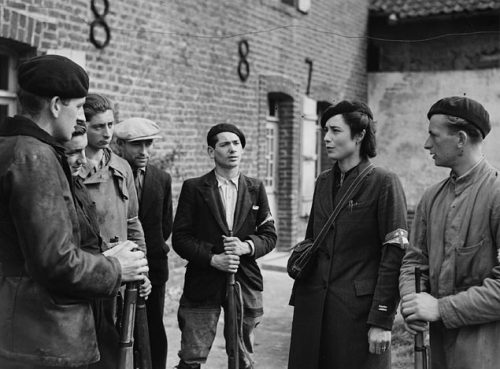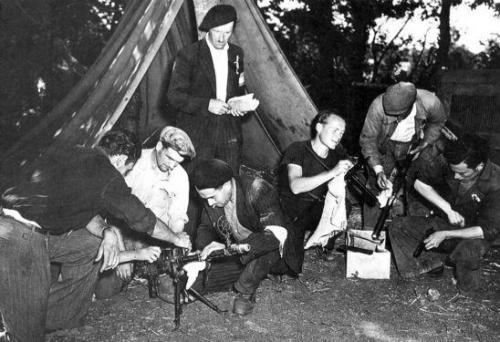secondworldwarineurope: “The Maquis were rural guerrilla bands of French Resistance
secondworldwarineurope:“The Maquis were rural guerrilla bands of French Resistance fighters, called maquisards, during the Occupation of France in World War II. Initially, they were composed of men who had escaped into the mountains to avoid conscription into Vichy France’s Service du travail obligatoire (STO) to provide forced labor for Germany. To avert capture and deportation to Germany, they became increasingly organized into active resistance groups.Most maquisards operated in the remote or mountainous areas of Brittany and southern France, especially in the Alps and in Limousin. They relied on guerrilla tactics to harass the Milice and German occupation troops. The Maquis also aided the escape of downed Allied airmen, Jews and others pursued by the Vichy and German authorities. Maquisards usually relied on some degree of sympathy or cooperation from the local populace. In March 1944, the German Army began a terror campaign throughout France. This included reprisals against civilians living in areas where the French Resistance was active (Oradour-sur-Glane massacre, Tulle murders). The Maquisards were later to take their revenge in the épuration sauvage that took place after the war’s end.Most of the Maquis cells — like the Maquis du Limousin or the Maquis du Vercors - took names after the area they were operating in. The size of these cells varied from tens to thousands of men and women.In French Indochina, the local resistance fighting the Japanese since 1941 was backed up by a special forces airborne commando unit created by de Gaulle in 1943, and known as the Corps Léger d’Intervention (CLI). They were supplied by airlifts of the British Force 136.Politically, maquis were very diverse — including right-wing nationalists, socialists, communists, and anarchists. Some Maquis bands that operated in southwest France were composed entirely of left-wing Spanish veterans of the Spanish Civil War. Spanish Civil War veteran Colonel Romero Giménez was a center democratic liberal operating from Bordeaux.When Germans began a forced labor draft (Service du travail obligatoire, STO) in France in the beginning of 1943, thousands of young men fled and joined the Maquis. The British Special Operations Executive (SOE) helped with supplies and agents. The American Office of Strategic Services (OSS) also began to send its own agents to France in cooperation with the SOE and the French BCRA agents in Operation Jedburgh.The British government also helped and supplied Charles de Gaulle to unify the Free French, resistance movement included.During the Allied invasion of Normandy, the Maquis and other groups played some role in delaying the German mobilization. The French Resistance (FFI Forces Françaises de l’Interieur for “French Forces of the Interior”) blew up railroad tracks and repeatedly attacked German Army equipment and garrison trains on their way to the Atlantic coast. Thanks to coded messages transmitted over the BBC radio, each Maquis group was alerted of the impending D-Day by listening for seemingly meaningless messages such as “the crow will sing three times in the morning” or any other pre-arranged messages read in a continuous flow over the British airwaves. As Allied troops advanced, the French Resistance rose against the Nazi occupation forces and their garrisons en masse. For example, Nancy Wake’s group of 7,000 maquisards was involved in a pitched battle with 22,000 Germans on June 20, 1944. Some Maquis groups took no prisoners so some German soldiers preferred to surrender to Allied soldiers instead of facing maquisards. Captured Maquis faced torture, death or concentration camps, where few survived.The Allied offensive was slowed and the Germans were able to counterattack in southeast France. On the Vercors plateau, a Maquis group fought about 8,000 soldiers under General Karl Pflaum (1890 – 1957), a defector Generalleutenant of the Third Reich and was defeated with 600 casualties during the Battle of Vercors Plateau.When General De Gaulle dismissed resistance organizations after the liberation of Paris, many maquisards returned to their homes. Many also joined the new French army to continue the fight.” (source)Images:Members of the Maquis in La Tresorerie.Heroes of the French resistance.In the more remote areas of France, small guerrilla groups known as the maquis spread terror among German troops; many had joined up to avoid the dread of German labour camps.Maquis of Plésidy – St-Connan – Coatmallouen. -- source link
Tumblr Blog : secondworldwarineurope-deactiva.tumblr.com
#history



